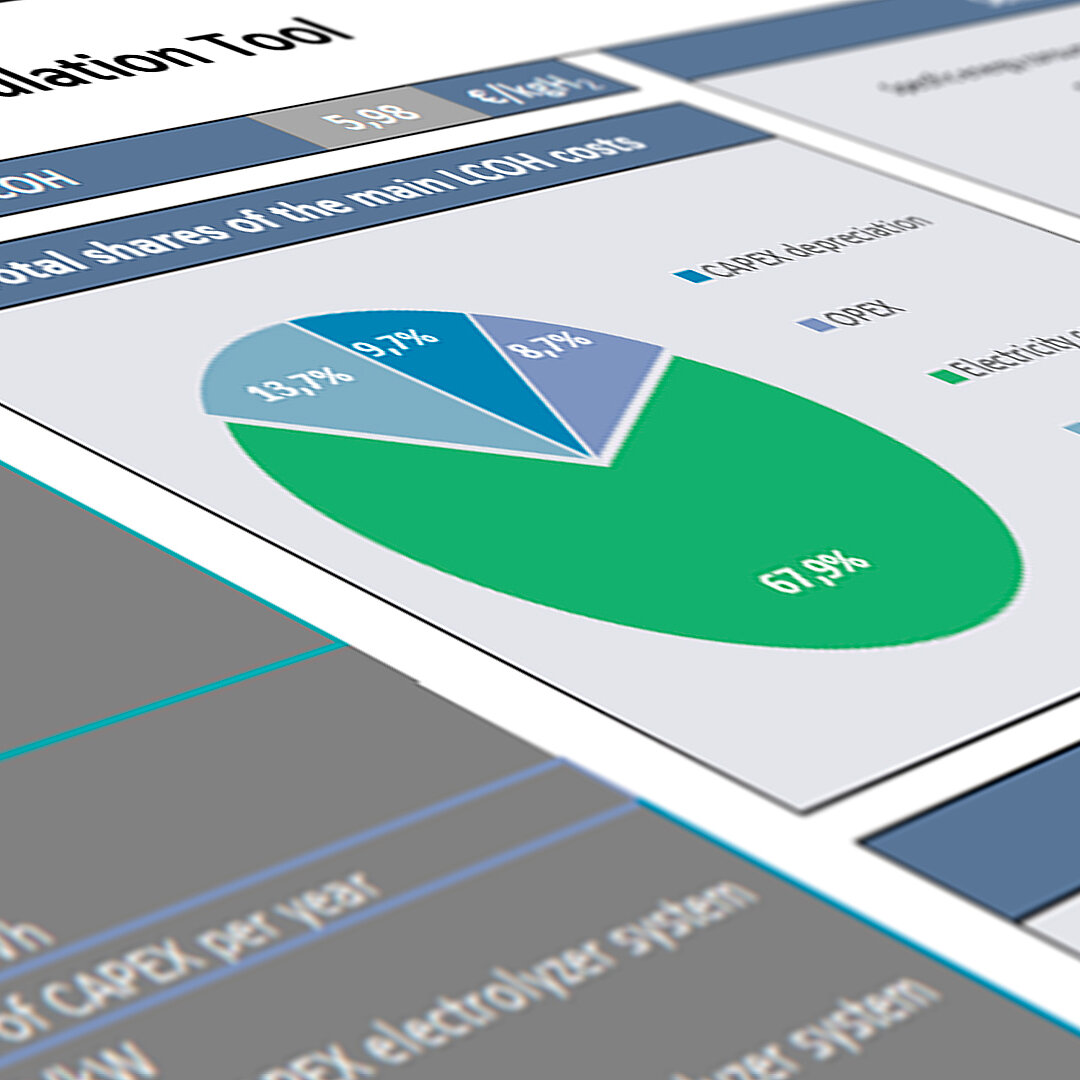- Authors
- Darlene D'Mello, Yu-Chi Chang, Dr. Leandro Janke
- Version number
- 1.0
- Publication date
-
3 July 2024
- Suggested Citation
- Agora Industry (2024): EU map of hydrogen production costs. Model version 1.0, Berlin, 11.06.2024
- Project
- This publication was produced within the framework of the project Trans4Real.
EU map of hydrogen production costs
A tool that helps to understand where and how the first wave of renewable hydrogen could be produced cost-effectively in Europe by 2030.

About this tool
The EU map of hydrogen production costs is a digital tool that shows with high spatial resolution the levelised cost of renewable hydrogen in Europe, based on solar PV and wind energy costs. To optimise the different components required for hydrogen production according to locally available resources, an in-house model based on the PyPSA framework was developed, and the results displayed for different technological scenarios. The tool provides insights into how regions rich in renewable energy resources can benefit from the energy transition by attracting energy-intensive industries seeking low-cost renewable energy, or by exporting hydrogen-based molecules to other parts of Europe.
Renewable energy as the starting point
Renewable hydrogen is a key element for Europe to reach its climate targets, as some applications depend on it to become climate neutral. For this purpose, additional renewable energy generation will be needed to convert electricity into hydrogen. Given their still untapped potential, both wind power and solar PV will become the most relevant energy sources for renewable hydrogen production in the years to come. However, optimal locations for deploying wind turbines and solar panels are not evenly distributed across Europe.
Where can we find low-cost renewable electricity?
Renewable electricity can already be produced at attractive costs just about everywhere in Europe. Especially low-cost locations for wind turbines are those where they can exceed 3000 full-load hours per year, mostly along, but not limited to, coastal areas of the North and Baltic Seas. Solar PV can already compete with conventional energy sources in a few regions in Europe. With anticipated declining investment costs in the next years, solar PV will rapidly become the lowest-cost option for producing electricity by 2030, especially in mountainous regions and in Southern Europe.
These hotspots will flourish as renewable energy hubs to supply Europe with the electricity needed to decarbonise not only the power sector but also to directly replace fossil fuels in certain industrial and transport applications.
Procuring electricity for hydrogen production
Project developers seeking to produce renewable hydrogen will naturally pursue business models that can secure the electricity needed to operate electrolysers with sufficient operating hours at affordable costs. Therefore, the decision on how to procure electricity will depend on several aspects, including the local availability of renewable energy resources, electricity market conditions and commercial maturity of electrolysers.
During the hydrogen market ramp-up it will be particularly important to operate electrolysers as much as possible to compensate for the higher investments needed. Pioneers in the market benefit most if they procure electricity directly from dedicated renewable energy facilities that have been optimised for the use of electrolysers, making hydrogen production cheaper.
In the longer term, when energy from wind and solar will predominate in electricity mixes, a different way to produce hydrogen will evolve, allowing electrolysers to be operated according to price signals from power markets. This new business model will also allow for low-cost hydrogen production even when operating electrolysers intermittently. Declining prices for electrolysers and a market design that incentivises such a business model will further boost competitiveness.
The Agora H2 PyPSA model focuses on describing optimal locations where the first wave of renewable hydrogen production in Europe may emerge by 2030.
How should hydrogen be produced in Europe?
Producing hydrogen from renewables will always add additional processing costs compared with electricity generation, driving up investment expenditure and causing efficiency losses. For this reason, whenever possible, the direct use of electricity should be prioritised.
For cases where hydrogen is truly needed, it will be crucial to find low-cost renewable energy alongside suitable locations where hydrogen can be stored to secure supply according to end-users' demand.
As of now, the market for renewable hydrogen is still in its infancy. It is therefore of critical importance to understand the various factors that govern the debate on hydrogen costs and prices. While the levelised cost of hydrogen can serve as a good indicator for broad analyses at the pre-feasibility level, it does not include project implementation costs or profit margins.
Therefore, the actual price for hydrogen on the market will likely be higher than the production costs and depend on supply and demand dynamics.
Insights on techno-economics
Due to the high variability in weather conditions across Europe, project developers will design hydrogen production based on different shares of wind power and solar PV for each region.
Together with oversizing the renewables capacity, these measures will allow electrolysers to operate more often (i.e. gaining higher full-load hours) resulting in lower hydrogen production costs. Finding such optimal plant configuration will be even more important for first movers seeking to enter the market during the ramp-up phase of the hydrogen economy when electrolyser investment costs are expected to be higher.
Furthermore, current high investment costs also influence the decision about where to deploy the first hydrogen plants until electrolyser costs come down, since the spread in cost of capital is considerably high among European countries.
Matching supply and demand
Hydrogen will only be produced at a large scale in locations where renewable energy is available at low costs. However, hydrogen demand is not limited to these prime production sites. Two options exist to match supply and demand: either by creating a delivery system to take hydrogen to the demand centres or by attracting off-takers to low-cost hydrogen producing regions.
In the case of hydrogen delivery, the most-discussed options rely on hydrogen transport via pipelines or shipping. While pipelines will be mostly restricted to pure hydrogen, shipping would allow a broad range of renewable molecules to be delivered.
The best-suited mode of delivery depends on both the distance and the final application. In terms of distance, short to medium ranges (0 – 3 500 km) are best served via hydrogen pipelines. In case of longer distances, the final application may play a decisive role since some hydrogen derivatives, such as ammonia and methanol, can be directly used by industrial consumers.
Reconverting a hydrogen carrier to pure hydrogen would come at the expense of the energy efficiency of the supply chain driving up delivery costs. Therefore, this approach is seen as the last resort for transporting hydrogen.
Download of modelling results
Join our H2 PyPSA mailing list to gain access of the modelling results and stay up-to-date about future developments.
To access the data file, kindly follow these steps:
- Click the "Subscribe to H2 PyPSA mailing list" button to open the registration form.
- Fill out the form with your e-mail address and additional voluntary information.
- Upon form submission, you will receive an email containing a confirmation link.
- Click on the confirmation link to verify your email address.
- Once verified, you will receive another email containing the password required for downloading the Excel data file.
- As soon as there are updates to the tool, we will notify you via our newsletter.
By clicking on the subscribe button, you will leave the Agora Industry website and be redirected to Cleverreach. We use this service provider to manage our newsletters. Please see our privacy policy for more information.
If you have any further questions or require assistance, please don't hesitate to reach out by sending an email to info(at)agora-industry(dot)org.
Bibliographical data
Downloads
- Documentation pdf 733 KB EU map of hydrogen production costs
-
Data Attachment
xlsx 2 MB
Modelling results
Data from model output (Version 1.0 – June 2024)
Please register to our H2 PyPSA mailing list to gain access.









